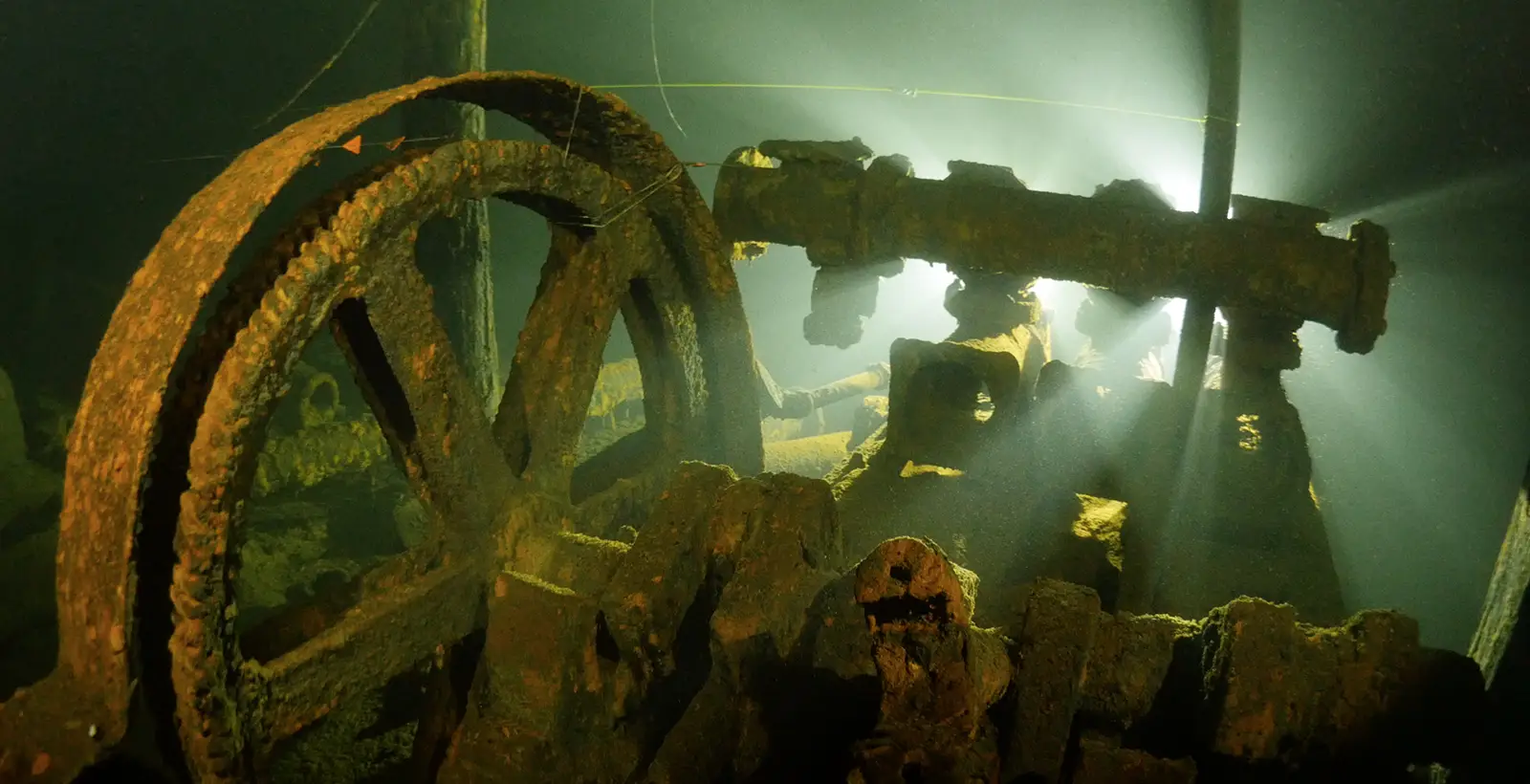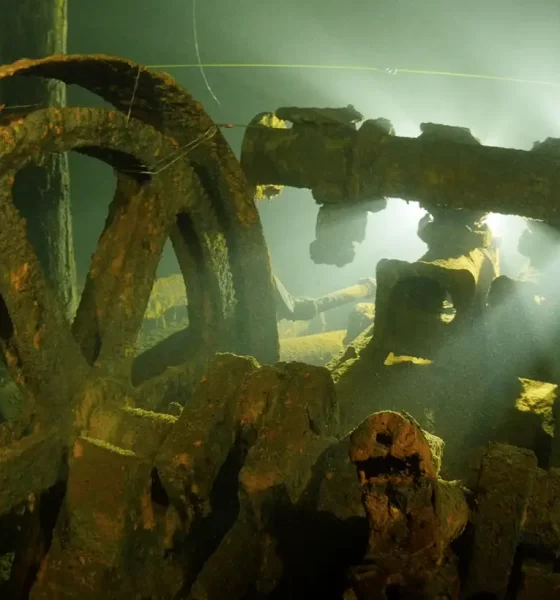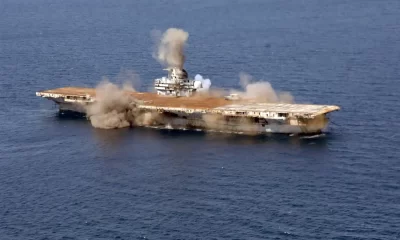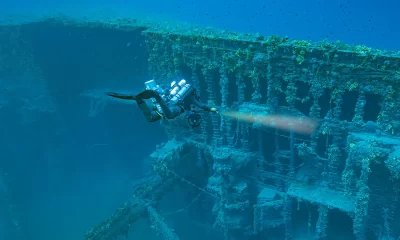

Latest Features
For Whom the Bell Tolls—Wreckers and Mine Divers!
Wanna go either wreck diving or underground diving? Why choose? As cave and tech instructor Lanny Vogel co-owner of Underground Tulum explains, storied Bell Island in Newfoundland has some of the best of both. Yes, be sure to bring your drysuit and heat if you’ve got it!
by Lanny Vogel. Lead image: Mine pumping station, photo courtesy of Jill Heinerth.
Most of the world’s bucket list technical diving destinations have either great wrecks or fabulous overhead diving. It is very unusual for any destination to have both, but Bell Island in Newfoundland, Canada is one of the few places on the planet that ticks all the boxes.

Bell Island lies in Conception Bay just a few miles from the Provincial capital and international airport of St John’s; it’s close to Cape Spear, the Easternmost point in the Americas. The presence of both wrecks and a mine are a result of the unusual geology of Bell Island. During its years of operation (1895 to 1966), the mine exported over 80 million tonnes/88 million tons, drawing from the rich deposits of ironstone that exist from close to the surface to a depth of 3.8 km/2.4 mi. Because iron ore was a hugely important strategic resource during World War II, the Kriegsmarine targeted ships transporting ore and sank four ships in two separate U-Boat attacks.
The most striking thing about all the wrecks is their pristine condition. Portholes, radio sets, and numerous other artefacts are still intact, even after so much time in the water. The first two wrecks were sunk on September 5, 1942, by U-513. Ironically, the Germans were very aware of the significance and capacity of Bell Island because Nazi Germany was the largest customer of the mine as they rearmed through the 1930s.

SS Saganaga sank first; it was one of four fully-loaded iron ore carriers anchored just off Lance Cove to the South of Bell Island. U-513’s first two launched torpedoes were not armed and failed to detonate. But they rectified the error, and the next two munitions to strike SS Saganaga exploded and broke her back; she sank in less than a minute, and twenty-nine sailors were lost. The crew of the nearby SS Lord Strathcona made the wise decision to abandon ship and all were safely in the lifeboats when U-513 claimed the second kill of the evening, sending her to the bottom with a further two torpedoes.

Three months later, on November 2, U-518 conducted a surface attack on the ships in the anchorage. The U-Boat struck SS Rose Castle with two torpedoes, and she sank rapidly. A third torpedo struck the Scotia Pier, giving Bell Island the dubious distinction of being one of the few pieces of land to be torpedoed by a submarine. U-518 continued the attack, firing a single torpedo into the stern of Ore Carrier PLM 27—she sank within a minute with further loss of life. The unusual name is an acronym for Paris, Lyon, and Marseilles. The vessel was originally built for Société Maritime de Transports et d’Affrètements, Rouen—a French company—and was transferred to the British Ministry of War Transport in 1940.
The Shipwrecks Today
All four wrecks lie upright and are of a similar size: between 5,500 – 7,500 tonnes/6,062 – 8,267 tons and between 120 – 140 m/400 – 455 ft in length. Their similar design will be familiar to many wreck divers: the bridge, superstructure, accommodation, and engine room are amidships, and holds for storage of the bulk iron ore cargo are fore and aft.



The relatively shallow depths mean that deco times are not too onerous, even in the cold water that ranges from 0 – 15 °C/32 – 59 °F, depending on the depth and time of year. SS Rose Castle is the deepest of the wrecks and lies in a depth of 49 m/160 ft to the seabed and 29 m/95 ft to the main deck.
Saganaga and Lord Strathallan are shallower, and PLM 27 is the shallowest of the four with depths from 15 – 30 m/50 – 100 ft. This means that her superstructure has sustained a little damage from passing icebergs, but she compensates by being the only wreck with a fully intact propeller. Other highlights are well-preserved engine rooms, deck guns, radio rooms, and brass portholes. Removing any artefacts is strictly forbidden. Seeing so much history intact and in situ is a real pleasure and lies in stark contrast to methodically and selfishly pillaged wrecks in other parts of the world.
Ocean Quest Adventures is the only company that runs regular trips to dive these wrecks, and their many years of experience mean that the dive facilities are first class. The Mermaid is a very well-appointed, 42-foot hardboat with deck space for twelve divers, a spacious cabin, and (possibly most importantly for lavishly equipped technical divers) a diver lift. All of the Ocean Quest team are living examples of the legendary Newfoundlander hospitality, and nothing is too much trouble. Snacks and hot soup are provided between dives—with moose soup identified as the firm favourite amongst most divers. All cylinders, sofnolime, oxygen, and nitrox fills are included within the cost of dives; divers can purchase helium at an additional cost.

The Bell Island Mine
The pristine wrecks alone make the trip to Newfoundland more than worthwhile; however, a few miles from the wrecks lies the world’s largest submarine iron ore mine. The Bell Island mine covers a total area of over 215 km2/83 mi2, has an estimated total length of passage exceeding 300 km/186 mi, and boasts a maximum depth of 4,800 m/15,748 ft. During a succession of Minequest expeditions, divers have installed line in a small fraction of the passages; but there is huge potential for further exploration. The lined passages include some fascinating artefacts including a pumping station, stables, tools, and mine trucks as well as a touching memorial to Joe Steffen, a diver that lost his life diving in the mine. Diving conditions are good with visibility in excess of 10 m/30 ft and a chilly but manageable 6 °C/43 °F year-round.



The logistics for diving the mine are extremely refined. Divers access Bell Island via a short ferry journey; the diveable Number 2 mine shares an entrance with the excellent Bell Island Mine Tour and Museum, and divers attract a few curious glances from the people on the “dry” tour. The water is approximately 250 m/820 ft from the entrance, down a 10-degree gravel slope. Ocean Quest has installed platforms to enter the water and solid kitting-up benches which make things very comfortable. On early expeditions, divers carried their own equipment. Today, an electric golf cart—named “Tony the Pony” after one of the longest-serving draft animals that worked the mine—makes cylinder and equipment transport a lot more efficient and easier on the legs.
Given the quality of the diving and the opportunity to dive first class wrecks on the same trip, the mine is dived surprisingly infrequently. The combination of pristine wrecks, challenging mine diving, and legendary Newfoundland hospitality makes for one of the most convivial, varied, and enjoyable diving experiences around.
Groups can book directly with Ocean Quest Adventures in Newfoundland, and Underworld Tulum will be running wreck and mine trips in 2025 and beyond.
Links
https://oceanquestadventures.com
https://bellislandminetour.com
https://www.wrecksandreefs.com
DIVE DEEPER
InDEPTH: Virtual Consensus on Mexican Cave Lines by Lanny Vogel
InDEPTH: Doppler Doodles by Steve Lewis

Lanny Vogel is a full-time cave, tech and CCR instructor based in Tulum, Mexico. He and his wife Claire are the owners of Underworld Tulum—a full service dive centre with on-site apartments for divers—and founded the annual Cave Camp event. He is also part of the CREER line and safety committee. Originally from the UK, he is a retired Commander Royal Navy with service in submarines, aircraft carriers, frigates, and on the ground in Iraq and Afghanistan.























































